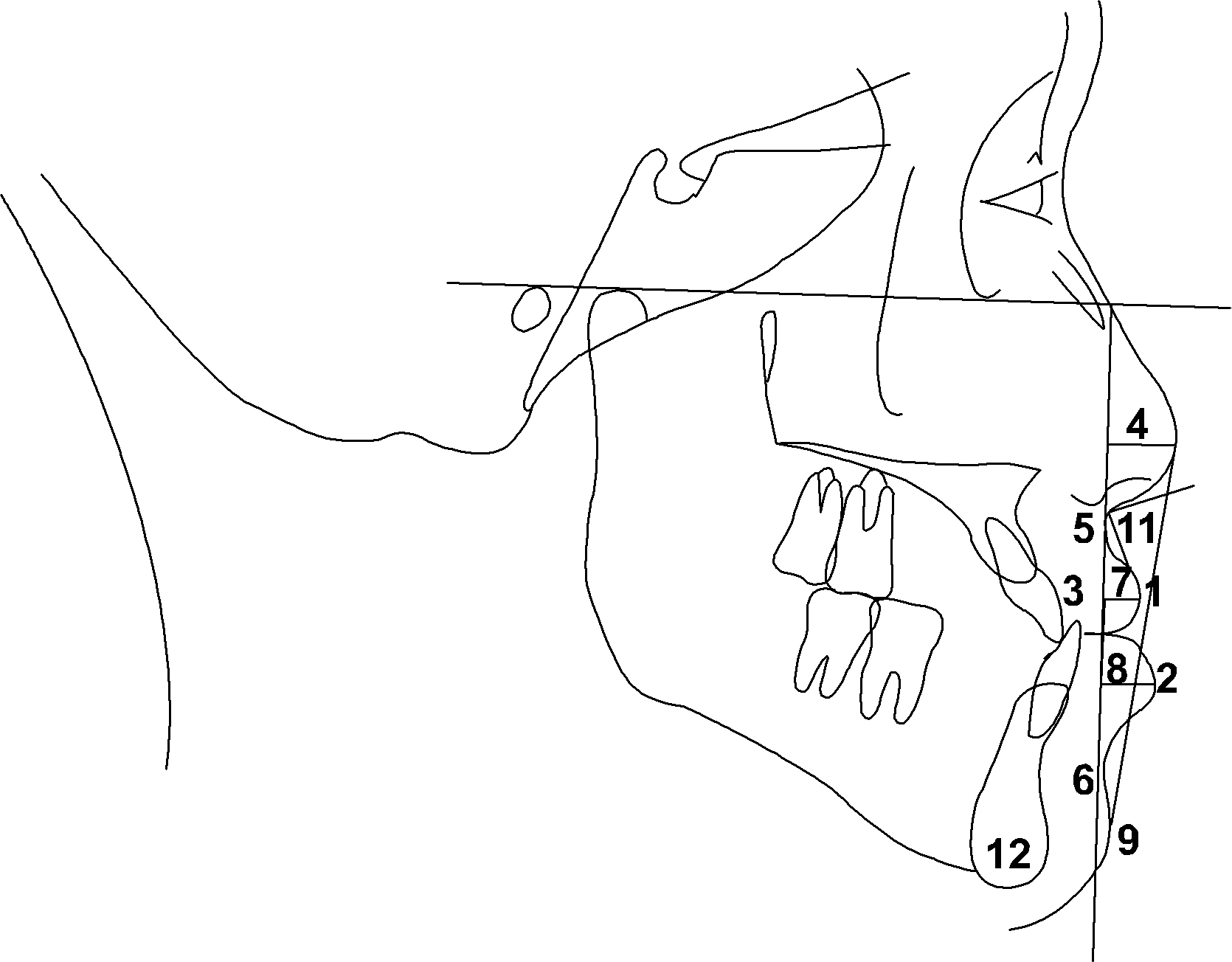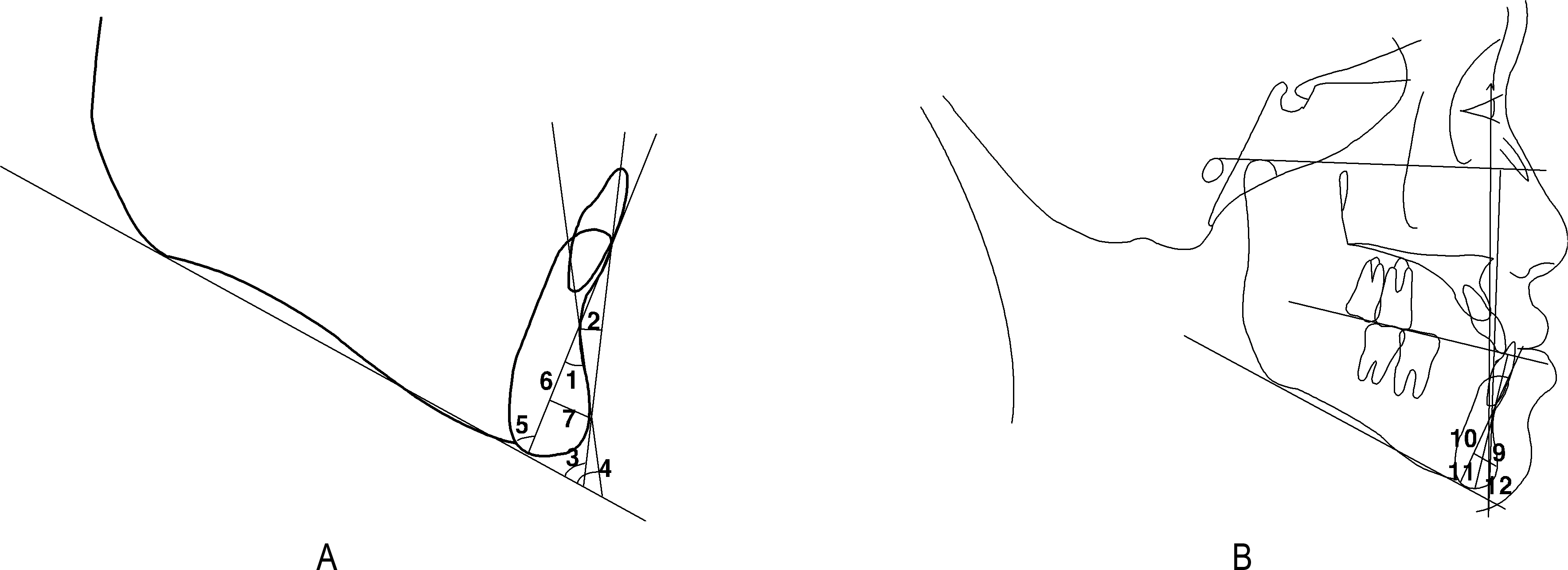Korean J Orthod.
2008 Feb;38(1):41-51. 10.4041/kjod.2008.38.1.41.
A comparative study of initial lateral cephalometric characteristics: mandibular setback surgery only versus mandibular setback surgery with advancement genioplasty
- Affiliations
-
- 1Department of Orthodontics, School of Dentistry, Kyunghee University, Korea. orthodrk@khu.ac.kr
- 2Kooalldam Dental Hospital, Korea.
- KMID: 1481504
- DOI: http://doi.org/10.4041/kjod.2008.38.1.41
Abstract
OBJECTIVE
The aim of this study was to compare the initial lateral cephalometric characteristics in two groups of patients: those that had mandibular setback surgery only and those that had mandibular setback surgery with advancement genioplasty.
METHODS
The lateral cephalograms of thirty-one patients were studied. Twenty-one Class III patients (group A) had only madibular setback surgery. Twelve Class III patients (group B) had mandibular setback surgery with advancement genioplasty.
RESULTS
Differences between two groups were found in N-Me, ANS-Me, Occlusal Plane angle, Palatal Plane to U1, Mandibular Plane to L1, Mandibular Plane to L6, SN to U1, Sn-Stms, and Pog' projection. Compared to group A, group B showed more linguoversion and extrusion of upper incisors, more extrusion of lower incisors and lower first molar, and more steepness of the occlusal plane. N-Me, ANS-Me, and Sn-Stms were also longer in group B. But Pog' projection was shorter than group A.
CONCLUSION
We conclude that certain initial lateral cephalometric characteristics may help indicate the inclusion of advancement genioplasty when mandibular setback surgery is planned in skeletal Class III patients.
Figure
Reference
-
1.Korean Council of Orthodontic Professors. Orthodontics. 2nd ed.Seoul: Narae Publishing;2006. p.115.2.Sugawara J., Mitani H. Facial growth of skeletal Class III malocclusion and the effects, limitations, and long-term dentofacial adaptations to chincap therapy. Semin Orthod. 1997. 3:244–54.3.Nanda R. Biomechanical and clinical considerations of a modified protraction headgear. Am J Orthod. 1980. 78:125–39.
Article4.Ishikawa H., Nakamura S., Iwasaki H., Kitazawa S., Tsukada H., Chu S. Dentoalveolar compensation in negative overjet cases. Angle Orthod. 2000. 70:145–8.5.Trauner R.., Obwegeser H. The surgical correction of mandibular prognathism and retrognathia with consideration of genioplasty. 1. Surgical procedures to correct mandibular prognathism and reshaping of the chin. Oral Surg Oral Med Oral Pathol. 1957. 10:677–89.6.Dal Pont G. Retromolar osteotomy for the correction of prognathism. J Oral Surg Anecth Hosp Dent Serv. 1961. 19:42–7.7.Epker BN. Modifications of the sagittal osteotomy of the mandible. J Oral Surg. 1977. 35:157–9.8.Proffit WR., White RP., Saver DM. Contemporary treatment of dentofacial deformity. St Louis: Mosby;2003.9.Guyer EC., Ellis EE., McNamara JA., Behrents RG. Components of Class III malocclusion in juveniles and adolescents. Angle Orthod. 1986. 56:7–30.10.Lew KKK., Foong WC. Horizontal skeletal typing in an ethnic clinese popluation with true class III malocclusion. Br J Orthod. 1993. 20:19–23.11.Kim JS. Esthetic orthognathic surgery for mandibular prognahtism. Seoul: Jisung Publishing;1999. p.11,71.12.Burch RJ., Bowden GW., Woodward HW. Intraoral one-stage ostectomy for correction of mandibular prognathism: report of case. J Oral Surg. 1961. 19:72–6.13.Hofer O. Operation der prognatic und mikrogenie. Dtsch Zahn Mund Kieferheilkd. 1942. 9:81–8.14.Bell WH., Gallagher DM. The versatility of genioplasty using a broad pedicle. J Oral Maxillofac Surg. 1983. 41:763–9.
Article15.Wolfe S. Chin advancement as an aid in correction of deformities of the mental and submental regions. Plast Reconstr Surg. 1981. 67:624–9.
Article16.Rosen HM. Aesthetic guidelines in genioplasty. the role facial disproportion. Plast Reconstr Surg. 1995. 95:470–2.17.Arnett GW., McLaughlin RP. Facial and dental planning for orthodontist and oral surgeons. St Louis: Mosby;2004. p.246.18.Kim YH., Vietas JJ. Anteroposterior Dysplasia Indicator: An Adjunct to Cephalometric Differential Diagnosis. Am J Orthod. 1978. 73:619–33.
Article19.Haskell BS. The human chin and its relationship to mandibular morphology. Angle Orthod. 1979. 49:153–66.20.Cha BK., Suhr CH. A study on the morphology of chin in relation to vertical sydplasia of craniofacial complex. Korean J Orthod. 1990. 20:135–55.21.Ricketts RM. The keystone triad II. Growth treatment, and clinical significance. Am J Orthod. 1964. 50:728–50.22.Aki T., Nanda RS., Currier GF., Nanda SK. Assessment of symphysis morphology as a predictor of the direction of mandibular growth. Am J Orthod Dentofacial Orthop. 1995. 106:60–9.23.Kim SJ., Son WS. A study on the relationship of the mandibular symphysis and aneterior alveolar and skeletal morphology according to the rotational growth pattern of mandible in skeletal Class III malocclusion. Korean J Orthod. 1999. 29:303–15.24.Kim SD., Kwon OW., Sung JH. The relationship between the morphology of mandibular symphysis and the craniofacial morphology in Class III malocclusion. Korean J Orthod. 1996. 26:509–22.25.Wolford LM., Chemello PD., Hilliard F. Occlusal plane alteration in orthognathic surgery-part 1: Effects on function and esthetics. Am J Orthod Dentofacial Orthop. 1994. 106:304–16.
- Full Text Links
- Actions
-
Cited
- CITED
-
- Close
- Share
- Similar articles
-
- Soft tissue changes associated with advancement genioplasty in skeletal class III individuals receiving mandibular set-back surgery
- Setback genioplasty with rotation for aesthetic mentolabial soft tissue: a case report
- Why most patients do not exhibit obstructive sleep apnea after mandibular setback surgery?
- A Study on the mandibular setback osteotomy and reduction genioplasty in mandibular prognathism with long anterior facial height
- New method for an evaluation of the esthetical improvements resulting from a mandibular angle reduction





